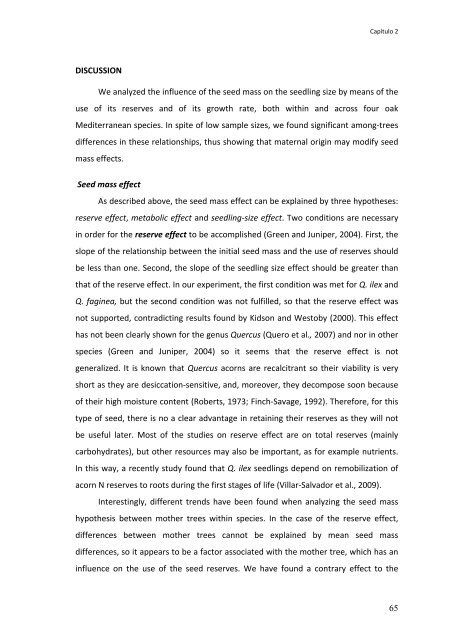Establecimiento de cuatro especies de Quercus en el sur de la ...
Establecimiento de cuatro especies de Quercus en el sur de la ...
Establecimiento de cuatro especies de Quercus en el sur de la ...
Create successful ePaper yourself
Turn your PDF publications into a flip-book with our unique Google optimized e-Paper software.
Capítulo 2<br />
DISCUSSION<br />
We analyzed the influ<strong>en</strong>ce of the seed mass on the seedling size by means of the<br />
use of its reserves and of its growth rate, both within and across four oak<br />
Mediterranean species. In spite of low sample sizes, we found significant among‐trees<br />
differ<strong>en</strong>ces in these r<strong>el</strong>ationships, thus showing that maternal origin may modify seed<br />
mass effects.<br />
Seed mass effect<br />
As <strong>de</strong>scribed above, the seed mass effect can be exp<strong>la</strong>ined by three hypotheses:<br />
reserve effect, metabolic effect and seedling‐size effect. Two conditions are necessary<br />
in or<strong>de</strong>r for the reserve effect to be accomplished (Gre<strong>en</strong> and Juniper, 2004). First, the<br />
slope of the r<strong>el</strong>ationship betwe<strong>en</strong> the initial seed mass and the use of reserves should<br />
be less than one. Second, the slope of the seedling size effect should be greater than<br />
that of the reserve effect. In our experim<strong>en</strong>t, the first condition was met for Q. ilex and<br />
Q. faginea, but the second condition was not fulfilled, so that the reserve effect was<br />
not supported, contradicting results found by Kidson and Westoby (2000). This effect<br />
has not be<strong>en</strong> clearly shown for the g<strong>en</strong>us <strong>Quercus</strong> (Quero et al., 2007) and nor in other<br />
species (Gre<strong>en</strong> and Juniper, 2004) so it seems that the reserve effect is not<br />
g<strong>en</strong>eralized. It is known that <strong>Quercus</strong> acorns are recalcitrant so their viability is very<br />
short as they are <strong>de</strong>siccation‐s<strong>en</strong>sitive, and, moreover, they <strong>de</strong>compose soon because<br />
of their high moisture cont<strong>en</strong>t (Roberts, 1973; Finch‐Savage, 1992). Therefore, for this<br />
type of seed, there is no a clear advantage in retaining their reserves as they will not<br />
be useful <strong>la</strong>ter. Most of the studies on reserve effect are on total reserves (mainly<br />
carbohydrates), but other resources may also be important, as for example nutri<strong>en</strong>ts.<br />
In this way, a rec<strong>en</strong>tly study found that Q. ilex seedlings <strong>de</strong>p<strong>en</strong>d on remobilization of<br />
acorn N reserves to roots during the first stages of life (Vil<strong>la</strong>r‐Salvador et al., 2009).<br />
Interestingly, differ<strong>en</strong>t tr<strong>en</strong>ds have be<strong>en</strong> found wh<strong>en</strong> analyzing the seed mass<br />
hypothesis betwe<strong>en</strong> mother trees within species. In the case of the reserve effect,<br />
differ<strong>en</strong>ces betwe<strong>en</strong> mother trees cannot be exp<strong>la</strong>ined by mean seed mass<br />
differ<strong>en</strong>ces, so it appears to be a factor associated with the mother tree, which has an<br />
influ<strong>en</strong>ce on the use of the seed reserves. We have found a contrary effect to the<br />
65

















